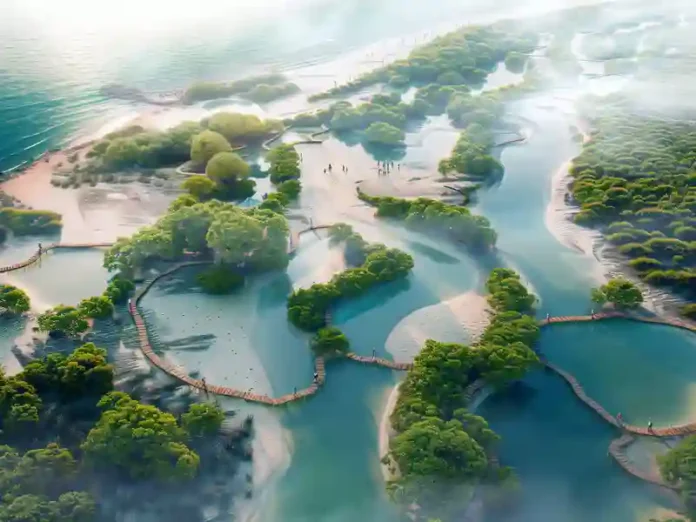Revolutionizing the Cityscape with a 72 km Coastal Regeneration Project
Dubai, renowned for its towering skyscrapers and innovative urban landscape, is now set to embark on a groundbreaking endeavor that could reshape its shores and redefine its environmental footprint.
In a visionary move, local firm Urb has unveiled plans for Dubai Mangroves, poised to become the world’s largest coastal regeneration project.
Spanning over 72 kilometers, Dubai Mangroves is not just an ambitious initiative; it’s a testament to Dubai’s commitment to combating climate change and fostering sustainable development.
At its core lies the plantation of over 100 million mangrove trees, a strategic effort to fortify coastal areas against erosion and rising sea levels while sequestering significant amounts of CO2 from the atmosphere.
“The heart of this initiative beats with the resilience of mangroves,” declares Urb. “These trees, with their remarkable ability to sequester carbon and provide vital support to marine ecosystems, are the cornerstone of our vision for a greener, more sustainable Dubai.”
The environmental benefits of Dubai Mangroves are nothing short of astounding. With each tree capable of absorbing approximately 12.3 kilograms of CO2 annually, the entire project could sequester a staggering 1.23 million tonnes of CO2 each year.
This remarkable feat would equate to removing the emissions of over 260,000 gasoline-powered vehicles annually, a significant contribution to mitigating climate change.
But Dubai Mangroves is not merely a carbon sink; it’s a thriving ecosystem in the making. By serving as nurseries for marine life, the mangrove forests will enhance fish stocks and contribute to the biodiversity of coastal waters.
Their intricate root systems will act as natural filters, improving water quality and promoting the health of marine habitats. To realize this monumental undertaking, Urb proposes harnessing the power of technology.
AI-powered drones and satellite imagery will be deployed to monitor and enhance the growth and health of the mangrove trees, ensuring their long-term viability and effectiveness in combating climate change.
Yet, Dubai Mangroves is more than just an environmental initiative; it’s a multifaceted project designed to enrich the lives of residents and visitors alike.
Alongside the sprawling mangrove forests, there will be pedestrian pathways, small beach parks, and vibrant social spaces, inviting people to connect with nature and each other.
A central visitor hub will educate and engage the community about the importance of mangroves and broader environmental challenges.
The inclusion of a botanic museum and nature center will further promote research, education, and environmental stewardship, fostering a culture of sustainability in Dubai.
Dubai Mangroves remains in the design stage, with Urb identifying six pilot studies to demonstrate its feasibility.
Against the backdrop of recent flooding incidents in Dubai, the project emerges as a beacon of hope and resilience, offering a sustainable alternative to the city’s relentless pursuit of monumental architecture.
In a city known for its towering ambitions, Dubai Mangroves stands as a testament to the power of innovation and collaboration in addressing the pressing challenges of our time.
As the project takes root and grows, it promises to not only transform Dubai’s coastline but also inspire cities around the world to embrace nature-based solutions in the fight against climate change.
With Dubai Mangroves, the desert metropolis is poised to redefine its skyline, not with steel and glass, but with the lush greenery of mangrove forests—a symbol of sustainability for generations to come.
This article was created using automation and was thoroughly edited and fact-checked by one of our editorial staff members

